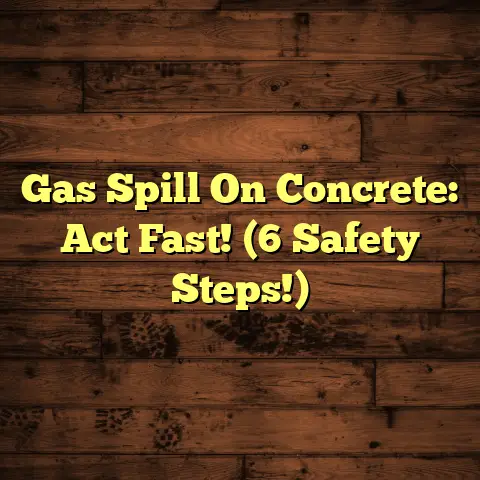How To Putty Hardwood Floors? (Explained)
Hardwood floors are a timeless choice for many homeowners. They add warmth and character to any space and can last for decades if properly maintained. However, one of the challenges that come with owning hardwood floors is managing the wear and tear they experience over time. This is where putty comes into play.
Putty for hardwood floors is a specialized filler material that addresses imperfections such as gaps, cracks, and holes in the wood. It serves both aesthetic and functional purposes. Aesthetically, it helps create a seamless look across the floor, while functionally, it protects the wood from moisture and dirt that can seep into these gaps and cause further damage.
My Journey with Hardwood Floors
When I first moved into my home, the hardwood floors were one of the selling points. They were beautiful, but after a few years of living there, I noticed some gaps forming between the boards. At first, I thought they were just a natural part of aging wood. However, as I researched more about hardwood maintenance, I realized that these gaps could lead to bigger issues if not addressed promptly.
Having never worked with putty before, I felt a bit overwhelmed at first. But I was determined to restore my floors to their former glory. Through trial and error, I learned valuable lessons about the process of applying putty to hardwood floors.
Gathering Materials
Before diving into the application process, I made a list of materials I would need. Here’s a comprehensive breakdown:
- Wood Putty:
- I chose a water-based putty for its ease of use and low odor. The cost was around $8 for a small tub that covered several square feet of gaps.
- Tip: Always choose a putty color that closely matches your floor stain to ensure a seamless finish.
- Putty Knife:
- A flexible putty knife is essential for applying the putty smoothly across the gaps. I spent about $5 on a 2-inch knife.
- Tip: A wider knife can help with larger gaps, while a smaller one can provide precision for tight areas.
- Sandpaper:
- I opted for 120-grit sandpaper to smooth out the surface after application. This cost around $3.
- Tip: Having multiple grits (80, 120, and 220) can be beneficial for various stages of smoothing and finishing.
- Stain or Finish:
- Matching the color of my hardwood floor was crucial. A small can of stain usually costs around $10.
- Tip: If you’re unsure about matching colors, buy sample pots rather than full cans.
- Clean Cloths:
- Essential for cleaning up excess putty and stain. I used old t-shirts and microfiber cloths.
- Protective Gear:
- This includes gloves and a mask to protect yourself from dust and fumes. A decent mask costs around $15.
- Tip: Always work in a well-ventilated area to avoid inhaling any harmful substances.
Assessing the Condition of My Floors
Before applying any putty, it’s important to thoroughly assess the condition of your hardwood floors. I took the time to inspect every inch of my flooring, measuring gaps with a ruler to determine their width and length. The majority were about 1/8 inch wide and up to 2 inches long.
In high-traffic areas such as the hallway and kitchen, the wear was more pronounced due to foot traffic and exposure to moisture from spills. Here’s how I approached my assessment:
- Visual Inspection:
- I walked around the house, looking for visible cracks or gaps.
- I noted areas where moisture had caused swelling or shifting in the boards.
- Measurement:
- Using a ruler, I measured the width and length of each gap.
- This helped me estimate the amount of putty needed for each section.
- Photographic Documentation:
- I took pictures of particularly problematic areas so that I could reference them later when planning my repairs.
- Prioritization:
- I prioritized areas based on severity; more significant gaps needed immediate attention, while minor ones could wait.
Preparation Process
Preparation is one of the most crucial steps in this entire process. A well-prepped area ensures that the putty adheres properly and looks great once finished.
Cleaning the Floor
The first step in preparation was cleaning the floor thoroughly. Dust and debris can prevent the putty from sticking properly. Here’s how I tackled this:
- Sweep and Vacuum:
- I began by sweeping the entire area to remove loose dirt.
- Next, I vacuumed to eliminate any remaining dust particles from between the floorboards.
- Mopping:
- After vacuuming, I used a damp mop with a mild detergent to clean any sticky or dirty spots.
- This ensured no residue would interfere with the putty application.
- Drying Time:
- After mopping, I allowed the floor to dry completely before proceeding. This took about an hour.
Assessing Humidity Levels
Since hardwood is sensitive to moisture, I checked the humidity levels in my home using a hygrometer. Ideally, indoor humidity should be between 30-50%. If it was too humid, it could affect how well the putty adhered.
Filling the Gaps
Now that everything was clean and dry, it was time to get started on filling those pesky gaps.
Applying the Putty
Using my putty knife, I began applying the wood putty:
- Scooping:
- I scooped out a small amount of putty with the knife—about the size of a quarter—and pressed it into one of the gaps.
- It was essential not to overload it; too much could overflow and create more work later.
- Smoothing:
- With firm pressure, I spread the putty across the gap until it was flush with the surrounding wood.
- For larger gaps, I found it helpful to apply multiple layers rather than one thick layer.
- Technique:
- A gentle scraping motion helped to ensure an even finish.
- For corners or tight spots, I used a smaller knife for better control.
Drying Time
Once all the gaps were filled, I allowed the putty to dry according to the manufacturer’s recommendations—about an hour in my case.
Sanding and Finishing
After allowing ample drying time, it was time to sand down the filled areas:
Sanding Process
- Choosing Sandpaper:
- I started with 120-grit sandpaper for initial smoothing.
- Afterward, I switched to 220-grit sandpaper for finer finishing touches.
- Technique:
- Using circular motions helped avoid gouging into the wood.
- After sanding each filled area, I wiped away dust with a damp cloth.
- Checking Levelness:
- After sanding, I ran my hand across each area to ensure everything felt smooth and level with the surrounding floor.
Staining
Once satisfied with the sanding results, it was time to apply stain:
- Choosing Stain Color:
- Based on my earlier color matching efforts, I selected a stain that closely resembled my existing floor color.
- Application:
- Using a clean cloth, I applied a thin layer of stain over each filled area.
- It’s important to blend it in well with surrounding boards for a seamless look.
- Drying Time:
- After applying stain, I allowed it to dry for approximately 24 hours before walking on it again.
Successes and Challenges
Reflecting on my experience with putting putty on hardwood floors, there were definitely both successes and challenges along the way.
Successes
- Improved Aesthetics:
- The most rewarding part was seeing how much better my floors looked after filling in those gaps.
- Increased Durability:
- Filling gaps not only improved appearance but also added longevity to my floors by preventing moisture from seeping underneath.
- Skill Development:
- I gained confidence in my DIY skills through this experience, which encouraged me to tackle other home improvement projects.
Challenges
- Color Matching:
- Initially, matching the stain color was difficult; my first choice was too dark.
- It took several attempts before getting it right—a lesson in patience!
- Sanding Technique:
- Learning how much pressure to apply while sanding took some trial and error.
- At one point, I accidentally sanded too deep in one area and had to reapply putty—a frustrating setback.
- Time Management:
- What I initially thought would take a few hours turned into an all-day project due to drying times and corrections.
- Planning ahead is crucial!
Alternative Approaches
Over time, I’ve experimented with different types of putties and methods for filling gaps in hardwood floors:
Oil-Based vs Water-Based Putty
- Oil-Based Putty:
- Pros: Excellent adhesion; durable once cured; great for high-traffic areas.
- Cons: Strong odor; longer drying times; cleanup requires solvents like mineral spirits.
- Water-Based Putty:
- Pros: Easy cleanup; low odor; quick-drying; non-toxic options available.
- Cons: May not adhere as strongly in high-wear areas; may require multiple applications.
Based on my experience, water-based putty is generally more user-friendly for DIY projects unless you’re working in areas subject to heavy wear.
Troubleshooting Common Issues
Despite careful preparation and execution, issues can arise during this process. Here are some common problems you might encounter along with their solutions:
Problem: Putty Doesn’t Adhere Properly
- Solution: Ensure that you’ve cleaned the area thoroughly before application and that there’s no moisture present. If necessary, lightly sand around the gap before applying putty again.
Problem: Visible Filler After Drying
- Solution: If your putty appears too light or dark after drying compared to surrounding wood, you may need to apply additional layers or adjust your stain application technique.
Problem: Overfilling Gaps
- Solution: If you accidentally overfill gaps during application, wait for it to dry completely before sanding down excess putty gently until level with surrounding wood.
Maintenance Tips
After completing this project, maintaining your hardwood floors becomes crucial to keeping them looking their best:
- Regular Cleaning:
- Sweep or vacuum regularly to remove dirt and debris that can scratch surfaces over time.
- Moisture Control:
- Use area rugs in high-traffic areas and monitor humidity levels in your home to prevent future gaps from forming.
- Periodic Inspections:
- Check for new gaps or damage periodically so you can address issues before they become severe.
Conclusion
Putting putty on hardwood floors is an essential skill for any homeowner who wants to maintain their investment in beautiful flooring. My journey began with uncertainty but transformed into an opportunity for learning and growth through hands-on experience.
While challenges arose along the way—like matching colors or dealing with drying times—the end result was worth every moment spent on this project. The satisfaction of seeing my floors restored has encouraged me to continue tackling other DIY tasks around my home.
Ultimately, whether you choose water-based or oil-based putty depends on your specific needs and preferences as each has its advantages and disadvantages. With patience and preparation, anyone can successfully enhance their hardwood floors’ beauty while protecting them from future damage—a rewarding endeavor indeed!





